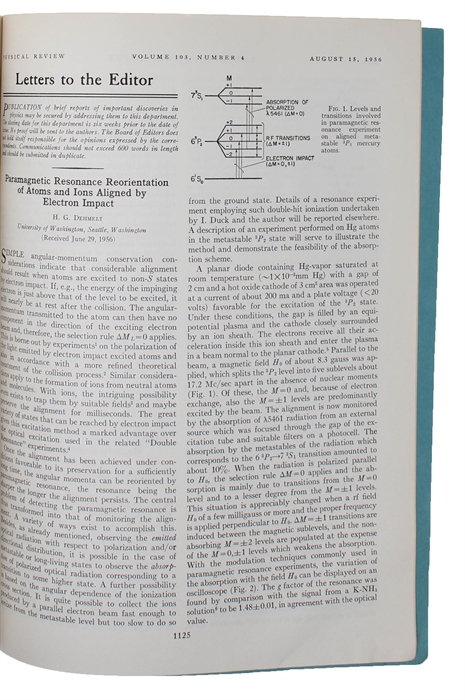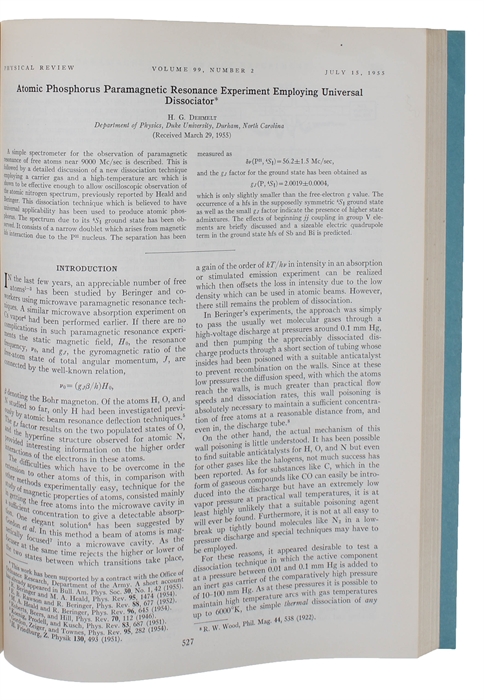DEVELOPMENT OF THE ION TRAP
DEHMELT, H. G. [HANS GEORG].
Atomic Phosphorus Paramagnetic Resonance Experiment Employing Universal Dissociator (+) Paramagnetic Resonance Reorientation of Atoms and Ions Aligned by Electron Impact (+) Slow Spin Relaxation of Optically Polarized Sodium Atoms (+) Modulation of a light beam by Processing Absorbing Atoms (+) Spin Resonance of Free Electrons Polarized by Exchange Collisions.
Lancaster, American Institute of Physics, 1955-1958. Lex8vo. Volume 99, July 15, No. 2, 1955; Volume 103, August 15, No. 4, 1956; Volume 105, March 1, No. 5, 1957; Volume 105, March 15, No. 6, 1957 and Volume 109, January 15, No. 2, 1958 of "The Physical Review", Second Series. Entire five volumes offered in the original printed blue wrappers. Stamp with previous owner's name to top of front wrappers on all issues except for volume 105, No. 5 with two stamps. A bit of wear to extremities, and a few scratches and tears to spines. Overall fine, and internally clean. Pp. 527-31; pp. 1125-26; pp. 1487-89; pp. 1924-25; pp. 381-85. [Entire volumes: Pp. 343-681; pp. 839-1135; pp. 1421-1682; pp. 1683-1955; pp. 227-631].
First publication of this series of papers in which Dehmelt developed the ion trap technique which awarded him the Nobel Prize of Physics in 1989. The ion trap is essential for the physical realization of quantum computation and quantum information processing. The ion trap (or Penning trap) is used in physics laboratires worldwide for example in CERN, the world's largest particle physics laboratory, where it is used to store antiprotons and high precision measurement of the magnetic moment of the electron (g-factor).
Dehmelt himself wrote about the discovery:
""Paramagnetic Resonance Reorientation of Atoms and Ions Aligned by Electron Impact." In this paper I first pointed out the usefulness of ion trapping for high resolution spectroscopy and mentioned the 1923 Kingdon trap as a suitable device. This work also brought me into close contact with spin exchange between electron and target atom, which gave me the idea for my 1958 experiment "Spin Resonance of Free Electrons Polarized by Exchange Collisions." However, first I had to learn how to produce polarized atoms, which could then transfer their orientation to trapped electrons. Falling back on buffer gas techniques developed in my 1955 Duke paper "Atomic Phosphorus Paramagnetic Resonance Experiment," I quickly demonstrated in my 1956 Seattle paper "Slow Spin Relaxation of Optically Polarized Sodium Atoms" how to efficiently produce and monitor a polarized atom cloud. Trapping the electrons in a neutralizing ion cloud slowly diffusing in the buffer gas, I was able to carry out the spin resonance experiment. My optical transmission monitoring scheme proved also very useful in the development of rubidium vapor magnetometers and frequency standards by Earl Bell and Arnold Bloom at Varian Associates, in which I acted as a consultant. The rubidium frequency standard is still the least expensive, smallest and most widely used commercial atomic frequency standard." (His Nobel Prize lecture).
Order-nr.: 43833


